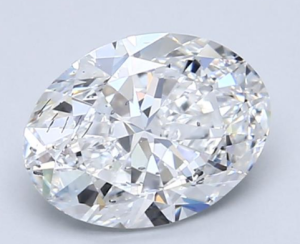Every diamond tells a story. Formed deep beneath the Earth’s surface, each one embarks on a billion-year journey, carrying with it unique marks of its past: diamond inclusions. These tiny characteristics – whether they’re small crystals, fractures, or cavities – provide a glimpse into a diamond’s history and contribute to its individual allure. In this guide, we’ll take a deeper look at diamond inclusions, shedding light on how they’re formed, their different types, and their influence on a diamond’s overall character.

- The Diamond Formation Process: The formation process of diamonds is a journey that begins over a billion years ago, about 100 to 120 miles beneath the Earth’s surface, in the mantle layer. This is a region of intense heat and pressure, where carbon atoms are subjected to such extreme conditions that they bond together in a specific configuration, forming a strong, three-dimensional lattice structure that makes diamonds the hardest known material on Earth. This process takes millions, if not billions, of years to complete.
- Inclusion of Foreign Materials: In the extreme environment where diamonds form, they are often not alone. There are a multitude of other minerals and gases present, suspended in the molten rock, or magma. As diamonds grow over millions of years, these other substances can become trapped inside the diamond’s structure, becoming a permanent part of the diamond. This is how inclusions are born. They are essentially frozen snapshots of what was occurring in the Earth’s mantle at the time the diamond was forming. Depending on the type and size of the trapped material, the inclusion may be visible to the naked eye or might only be seen under magnification.
- Variety of Inclusions: The variety of inclusions that can be found in diamonds is quite diverse and depends largely on what substances were present during the diamond’s formation. They can appear as tiny crystals if the inclusion is another mineral. These are often referred to as mineral inclusions and may be composed of garnet, pyrite, or even other diamonds. Diamonds can also have fractures, which are tiny breaks in the diamond’s structure. These occur if the diamond was subject to extreme forces or temperature changes either during or after its formation. Cavities are another type of inclusion that appears as small openings or holes in the diamond. These can occur if part of the diamond erodes or a crystal inclusion dissolves.
- Movement to the Surface: After their formation, diamonds remain in the Earth’s mantle until a very specific type of volcanic eruption occurs. Kimberlite eruptions are highly explosive events that occur when magma from deep within the Earth’s mantle quickly rushes to the surface. This magma carries with it chunks of the mantle, and these chunks can contain diamonds. The violence of these eruptions, however, can cause additional inclusions, fractures, or irregularities to form within the diamond.
- Post-Formation Changes: Just as diamonds can be changed and shaped during their formation, they can also be altered after their formation. For example, natural radiation from nearby rocks can alter a diamond’s color and create new inclusions known as graining. Heat can also affect diamonds, causing existing inclusions to change or new ones to form. These post-formation processes create further diversity in the types of inclusions found in diamonds and contribute to each diamond’s unique characteristics.
- During Cutting and Polishing: Once a diamond is brought to the surface and recovered, it still has one more journey to make before it’s ready to be sold: the cutting and polishing process. This is where the diamond is transformed from a rough stone into the brilliant gem we’re familiar with. However, if the diamond is handled roughly or mistakes are made during these processes, it can result in additional inclusions. For example, the diamond might be nicked, causing a tiny indentation, or too much heat might be applied, causing a fracture.
In Conclusion
Diamond inclusions are fascinating remnants of a diamond’s formation process, encapsulating a tale of intense pressure, extreme heat, and geological events that spanned millions, even billions, of years. These natural, internal characteristics not only contribute to a diamond’s unique appeal but also serve as nature’s proof of authenticity. They provide each diamond with its distinct identity, telling the story of its incredible journey from deep within the Earth to becoming a symbol of love and commitment. Just as we value the unique characteristics that make us who we are, inclusions remind us that it’s the imperfections that make diamonds – and our stories – truly beautiful.